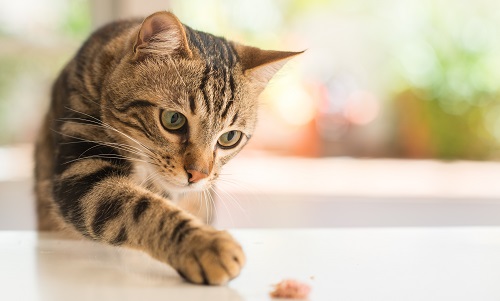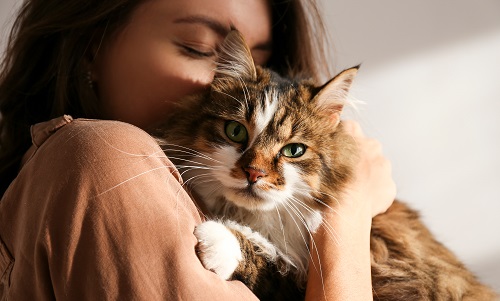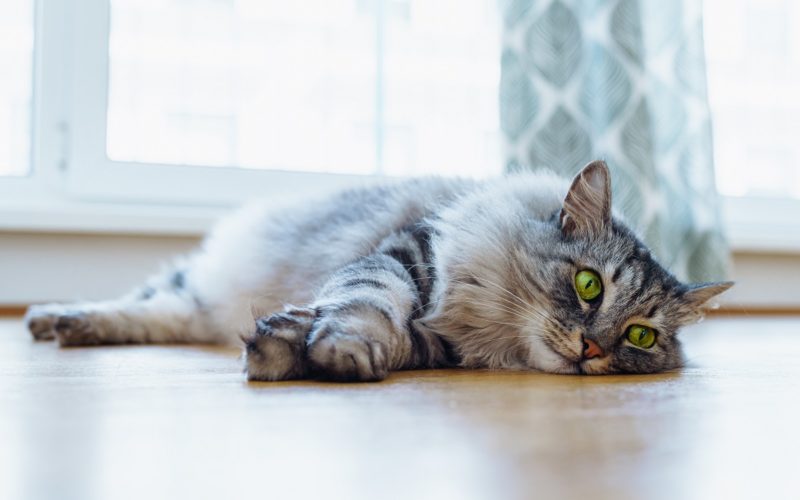Soft, fluffy, or silky smooth—when you reach down to pet your cat, you expect a cozy coat of fur to scratch. Unfortunately, that’s not always the case. Mange is a contagious skin condition caused by parasites that can affect cats (as well as other animals) and leave their skin irritated and their fur worse for the wear. Your feline friends can go through medical conditions that can leave you worried and scared, from mange to feline dysautonomia and more. But it’s important to know how to treat them, or even prevent them before they happen.
So what is there to know about feline mange? Plenty.
We’re going to dive deep into the different types of mange, as well as the symptoms, side effects, treatment, and prevention methods to ensure you’re prepared to protect your furball from this unpleasant condition. If you’re worried about your cat’s coat and overall health, read on to answer the question, “What is mange in cats?”
Different Types of Mange
Not all mange is the same. While you might be familiar with the image of a “mangey cat,” there’s a lot more than just bald patches and itching when it comes to mange in kittens. The following are the different types of mange that you should be aware of as a cat owner.
Notoedric Mange (Feline Scabies)
This variation of feline mange is highly contagious to cats and humans alike. Caused by Notoedres cati mites, these microscopic parasites latch onto cats and lay eggs below their skin.1 Once the eggs hatch, your cat’s fur may become totally infested, resulting in painful symptoms including:
- Itching – Irritation and itching are par for the course with most versions of mange, and notoedric mange is no different. Scratching and overgrooming can quickly lead to hair loss and further skin problems for cats suffering from these pesky parasites.
- Scabs – Telltale signs of mange include scab formations around the most infested areas on your cat’s body, most commonly, the head, stomach, feet, and tail. Scaly, crusty ears are also frequently associated with notoedric mange.
- Yellowed skin – As notoedric mange progresses, your cat’s skin may take on a yellowish tint and thicken, due to the mite infestation. This color change may be most visible after some hair loss has occurred.
In the US, notoedric mange is most commonly found in specific geographic locations—notably southern California—where the parasites thrive.2 The highly contagious nature of the mites makes it difficult to completely eradicate them from an area.
As mentioned, humans are susceptible to notoedric mange. Consider handling your cat with gloves if you believe they’re dealing with a case of notoedric mange, and bring them to a vet as soon as possible for a proper diagnosis. Additionally, if you have any other animals in the house, you should bring them along for a mange check as well. You can never be too safe when dealing with pests and parasites.
Sarcoptic Mange (Canine Scabies)
Canine scabies isn’t just for dogs. Despite your cat’s feline disposition, the same Sarcoptes scabiei mites can move from dog to cat and even to human in some circumstances.3 These mites typically only live for a few weeks at most, but that’s enough time for them to settle into your cat’s fur and make a disgusting little home for themselves.
Worried that your cat might be dealing with sarcoptic mange? Look out for the following symptoms:
- Bumps and irritation – Mites, eggs, and bites lead to visible skin irritation and inflammation. If your cat has mange, you may begin to notice bumps appearing on their skin. Even if you can’t see the bumps, you may be able to feel them when you pet your cat. Those aren’t goosebumps.
- Sores – The longer your cat deals with sarcoptic mange, the more likely they will scratch at their skin to the point of developing sores. These small open wounds leave your cat vulnerable to secondary skin infections that can double their discomfort and further complicate their health.
- Oily dandruff – While most of us imagine dandruff to be dry and flakey, the skin problems associated with sarcoptic mange can result in an oilier variation of this unpleasant skin problem. If you notice flaking or whitish residue coming off your cat, it could be a result of an infestation.
The risks of untreated sarcoptic mange can be deadly serious. Without proper veterinary attention, sarcoptic mange can lead to emaciation and even death in some instances.4 While there’s no reason for this skin infection to turn into a life or death illness, you should always arrange a veterinary appointment as soon as possible to bring your cat relief.
Otodectic Mange (Ear Mites)
Noticing an issue with your cat’s ears? While not necessarily thought of as a skin problem, otodectic mange is also caused by mite infestations in cats. Better known as ear mites, these parasites bury themselves in the external ear and ear canal, feeding off ear wax and oils.5
Common symptoms of otodectic mange include:
- Head shaking – Does it look like your cat is trying to shake something out of their ear? Scratching and head shaking is a cat’s natural reaction to an internal ear issue. This odd behavior is usually very obvious and easy to spot.
- Black discharge – Foul-smelling black discharge is a common side effect of an ear mite infection. This discharge is a mixture of ear wax, blood, and mites, pushed out by the ear canal.6
- Red ears and inflammation – As your cat’s otodectic mange continues to irritate their external ear, you may notice a bright red tinge and inflammation around the infected area.
Bacterial yeast infections frequently display the same symptoms as ear mites, making it all the more important that you get a proper diagnosis if you suspect an ear-related issue. If left unchecked, ear mites can lead to torn eardrums and potential deafness in cats.
Cheyletiellosis (Walking Dandruff)
Identifiable by white dandruff, cheyletiellosis mites cause surface skin to dry and flake off.7 It can also cause irritation and rashes in humans. Looking at your own skin may be one way of knowing if your cat is dealing with cheyletiellosis.
Cheyletiellosis may be confused with standard dandruff related to dry skin, if not for the following signs:
- Walking dandruff – Dandruff on your cat’s skin may appear to move or “walk” due to the movement of the mites on the surface. While your cat’s skin may become scaly or flaky, this movement is a result of a mite infestation.
- Excessive grooming – In an attempt to rid themselves of mites, your cat may engage in aggressive grooming. Nonstop licking of specific parts of their body is a dead giveaway that they’re suffering from some variation of mange.
Some cats may not show any symptoms at all, making cheyletiellosis very difficult to spot. These cats can still transmit the mites to other animals or humans. Be vigilant to assure you’re not dealing with an asymptomatic case by keeping tabs on all the animals in your household.
Treatment for Mange in Cats
After taking skin samples and examining them under a microscope, your vet can determine the type and severity of mange. After that, it’s in their hands to provide you with the tools necessary to eliminate the parasites and get your kitty back to their old self.
When offering treatment, vets will commonly prescribe:
- Topical or oral medication – Your vet may offer you a medication used to exterminate the eggs and mites living on your cat’s skin. Often, these are the same medicines used to treat fleas or other common parasites. In the case of multiple parasites, it may be possible to eliminate them all in one fell swoop.8
- Antibiotics – While antibiotics aren’t used to treat mange directly, the related skin infections, symptoms, and inflammation can be helped by veterinary antibiotics.
- Prescription shampoo – Bathe your cat with some veterinary shampoo designed to quickly dispose of unwanted parasites. It may take a few baths, so do your best to make the ordeal as pain-free as possible by offering treats and praise to your water-logged cat.
- Ear drops – Usually only prescribed for otodectic mange, ear drops can eliminate mites living in the ear canal and provide fast relief for your kitty. Cats are typically averse to ear drops, so you may have to do some wrangling to get them to sit still. They’ll appreciate it even if they’re clawing you as you squeeze the dropper.
To help out during mange treatment, you may opt for a healthy supplement to boost your cat’s comfort. Full-Spectrum CBD can provide mental and physical health benefits that will keep your cat’s spirits high as they deal with whatever the vet prescribes. Full-spectrum CBD for cats has many other benefits, including aiding in pain relief, anxiety, and more. And if you’re wondering about your cat’s separation aniety or curious about how long can you leave a cat alone, it worth looking into how CBD can be beneficial in this case as well.
Preventing Mange in Cats
Pet owners know that health and happiness go hand-in-hand. Keeping your cat safe from parasites and skin disorders is a chief concern for everyone with a four-legged friend in their life. No one wants to put their cats through an exhausting ordeal, so prevention is always the first step.
Keep your precious kitties fur pristine by taking note of the following mange prevention methods:
- Stay away from stray cats
- Create a clean environment
- Regular bathing
- Have new homes thoroughly checked for pests
- Always monitor your cat’s behavior and health.
The best way to ensure your cat doesn’t catch any unwanted parasites is by keeping them inside. While some cats can’t live without some outdoor time, many can be perfectly happy living indoors. So long as you provide your kitten with plenty of playtime and affection, they should be more than willing to stay snuggled up in your home.
Keep Your Cat Comfortable with Canna-Pet
Whether you’re worried your cat has contracted mange or looking for the best way to stop them from ever coming in contact with unwanted parasites, you should have the knowledge you need to keep your cat safe. In addition, If you’re interested in providing a simple and safe boost for your cat, it might be time to check out Canna-Pet.
We’re the cat CBD experts, providing safe, veterinarian-recommended products to keep your cat calm and comfortable. Our full-spectrum CBD capsules deliver concentrated cannabinoids to your cat without any psychoactive effects. Add CBD to your cat’s daily meal to discover why so many cat owners think Canna-Pet is the cat’s meow. Visit us today.
Sources:
- Wag!. Notoedric Mange in Cats. https://wagwalking.com/cat/condition/notoedric-mange
- Mar Vista Animal Medical Center. Notoedric Mange. https://www.marvistavet.com/notoedric-mange.pml
- Pet Place. Overview of Sarcoptic Mange in Cats.https://www.petplace.com/article/cats/pet-health/sarcoptic-mange-in-cats/
- Merck Veterinary Manual. Mite Infestation (Mange, Acariasis, Scabies) of Cats. https://www.merckvetmanual.com/cat-owners/skin-disorders-of-cats/mite-infestation-mange,-acariasis,-scabies-of-cats
- Blue Cross. Ear mites in cats.https://www.bluecross.org.uk/advice/cat/ear-mites-in-cats
- Hartz. How to Treat Your Cat for Ear Mites.https://www.hartz.com/how-to-treat-your-cat-for-ear-mites/
- Pets and Parasites. Dandruff. https://www.petsandparasites.org/cat-owners/dandruff/
- Small Door Veterinary. Sarcoptic Mange in Cats. https://www.smalldoorvet.com/learning-center/medical/sarcoptic-mange-cats





